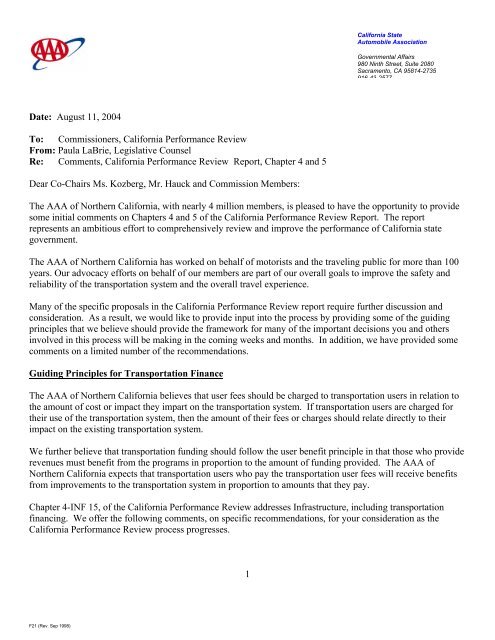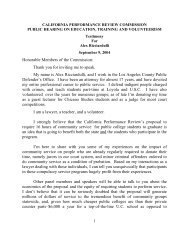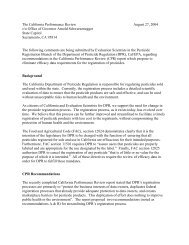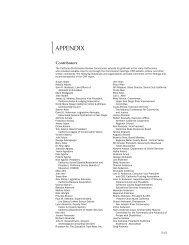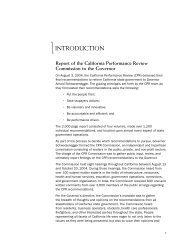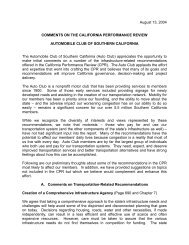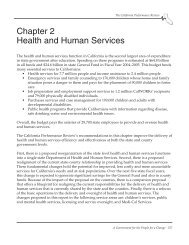AAA of Northern California - The California Performance Review
AAA of Northern California - The California Performance Review
AAA of Northern California - The California Performance Review
You also want an ePaper? Increase the reach of your titles
YUMPU automatically turns print PDFs into web optimized ePapers that Google loves.
<strong>California</strong> State<br />
Automobile Association<br />
Governmental Affairs<br />
980 Ninth Street, Suite 2080<br />
Sacramento, CA 95814-2735<br />
916 43 2577<br />
Date: August 11, 2004<br />
To: Commissioners, <strong>California</strong> <strong>Performance</strong> <strong>Review</strong><br />
From: Paula LaBrie, Legislative Counsel<br />
Re: Comments, <strong>California</strong> <strong>Performance</strong> <strong>Review</strong> Report, Chapter 4 and 5<br />
Dear Co-Chairs Ms. Kozberg, Mr. Hauck and Commission Members:<br />
<strong>The</strong> <strong>AAA</strong> <strong>of</strong> <strong>Northern</strong> <strong>California</strong>, with nearly 4 million members, is pleased to have the opportunity to provide<br />
some initial comments on Chapters 4 and 5 <strong>of</strong> the <strong>California</strong> <strong>Performance</strong> <strong>Review</strong> Report. <strong>The</strong> report<br />
represents an ambitious effort to comprehensively review and improve the performance <strong>of</strong> <strong>California</strong> state<br />
government.<br />
<strong>The</strong> <strong>AAA</strong> <strong>of</strong> <strong>Northern</strong> <strong>California</strong> has worked on behalf <strong>of</strong> motorists and the traveling public for more than 100<br />
years. Our advocacy efforts on behalf <strong>of</strong> our members are part <strong>of</strong> our overall goals to improve the safety and<br />
reliability <strong>of</strong> the transportation system and the overall travel experience.<br />
Many <strong>of</strong> the specific proposals in the <strong>California</strong> <strong>Performance</strong> <strong>Review</strong> report require further discussion and<br />
consideration. As a result, we would like to provide input into the process by providing some <strong>of</strong> the guiding<br />
principles that we believe should provide the framework for many <strong>of</strong> the important decisions you and others<br />
involved in this process will be making in the coming weeks and months. In addition, we have provided some<br />
comments on a limited number <strong>of</strong> the recommendations.<br />
Guiding Principles for Transportation Finance<br />
<strong>The</strong> <strong>AAA</strong> <strong>of</strong> <strong>Northern</strong> <strong>California</strong> believes that user fees should be charged to transportation users in relation to<br />
the amount <strong>of</strong> cost or impact they impart on the transportation system. If transportation users are charged for<br />
their use <strong>of</strong> the transportation system, then the amount <strong>of</strong> their fees or charges should relate directly to their<br />
impact on the existing transportation system.<br />
We further believe that transportation funding should follow the user benefit principle in that those who provide<br />
revenues must benefit from the programs in proportion to the amount <strong>of</strong> funding provided. <strong>The</strong> <strong>AAA</strong> <strong>of</strong><br />
<strong>Northern</strong> <strong>California</strong> expects that transportation users who pay the transportation user fees will receive benefits<br />
from improvements to the transportation system in proportion to amounts that they pay.<br />
Chapter 4-INF 15, <strong>of</strong> the <strong>California</strong> <strong>Performance</strong> <strong>Review</strong> addresses Infrastructure, including transportation<br />
financing. We <strong>of</strong>fer the following comments, on specific recommendations, for your consideration as the<br />
<strong>California</strong> <strong>Performance</strong> <strong>Review</strong> process progresses.<br />
1<br />
F21 (Rev. Sep 1998)
Proposition 42<br />
<strong>AAA</strong> <strong>of</strong> <strong>Northern</strong> <strong>California</strong> agrees that the <strong>California</strong> Constution should protect revenue derived from the sales<br />
tax on gasoline (Proposition 42) consistent with constitutional protections for other gas tax revenue. When<br />
voters approved Proposition 42 by almost 70%, they sent a clear message that they wanted additional resources<br />
and all <strong>of</strong> the taxes they pay on motor vehicle fuels committed to transportation for congestion relief and<br />
improved traffic safety. However, since its inception, Proposition 42 revenue has been diverted to purposes<br />
other than transportation. <strong>The</strong>se diversions have resulted in an annual loss <strong>of</strong> up to $1.2 billion in transportation<br />
funding for the past few years. Diversions <strong>of</strong> transportation revenue make long term planning difficult, result in<br />
project delay and continued traffic congestion. <strong>AAA</strong> <strong>of</strong> <strong>Northern</strong> <strong>California</strong> believes that voters should have<br />
the opportunity to amend the <strong>California</strong> Constitution to remove the Proposition 42 triggering mechanism and to<br />
provide for the repayment <strong>of</strong> loans from Proposition 42 revenue, with interest.<br />
Article XIX derivative revenue<br />
<strong>AAA</strong> <strong>of</strong> <strong>Northern</strong> <strong>California</strong> also agrees that revenues generated from the investment <strong>of</strong> gasoline excise taxes<br />
should be earmarked for transportation. Article XIX <strong>of</strong> the <strong>California</strong> Constitution requires gasoline excise<br />
taxes to be earmarked for certain transportation purposes. It seems logical to also earmark revenue derived<br />
from the investment <strong>of</strong> Article XIX revenue to transportation.<br />
Vehicle Miles Traveled<br />
With caution and through the use <strong>of</strong> pilot projects, <strong>California</strong> could also explore alternative ways to fund its<br />
transportation infrastructure. We anticipate that the concept <strong>of</strong> substituting a vehicle miles traveled (VMT)<br />
system in place <strong>of</strong> the long-standing gasoline tax, as a highway user fee, would not be met without some<br />
controversy. Issues that might warrant consideration include the fairness <strong>of</strong> a VMT system on those vehicle<br />
owners who choose to purchase a more fuel efficient or hybrid vehicle and the fairness <strong>of</strong> a VMT system on<br />
those vehicle owners who live in more widespread geographical areas <strong>of</strong> the state or who must undergo longer<br />
commutes between, for example, work and home. <strong>AAA</strong> <strong>of</strong> <strong>Northern</strong> <strong>California</strong> believes that this state should<br />
closely monitor the Oregon VMT pilot project prior to reaching any conclusions for implementation in<br />
<strong>California</strong>.<br />
Toll Roads<br />
<strong>The</strong> use <strong>of</strong> toll roads is another alternative transportation financing method that has garnered recent attention.<br />
We believe that the ultimate success or failure <strong>of</strong> toll roads in <strong>California</strong> has not yet been determined and that<br />
the following guidelines are critical to any toll road proposal: Existing mixed flow highway facilities and lanes<br />
should not be tolled; that there should be reasonable free alternatives to tolled facilities; and that as a general<br />
principle, to better protect public interest, toll roads should be publicly owned and operated. However, if tolls<br />
roads are privately owned and operated, there must be assurances that the public interest should be protected,<br />
including assuring that critical safety and capacity improvements can always be made. <strong>AAA</strong> <strong>of</strong> <strong>Northern</strong><br />
<strong>California</strong> also believes that tolls should not be treated as general revenues. <strong>The</strong>y, instead, should be limited in<br />
use to repaying construction and operation costs <strong>of</strong> the same facility from which they are collected or for the<br />
provision <strong>of</strong> transportation services in the same corridor that provide traffic congestion relief.<br />
Guiding Principles for Transportation Energy and the Environment<br />
<strong>The</strong> transportation system is dependent upon a reliable supply <strong>of</strong> transportation energy and the transportation<br />
system has effects upon the environment, particularly upon air quality. <strong>AAA</strong> <strong>of</strong> <strong>Northern</strong> <strong>California</strong> recognizes<br />
that protecting and improving air quality, water quality, and other aspects <strong>of</strong> the natural environment are<br />
essential to ensuring public health, protecting natural resources and promoting a high quality <strong>of</strong> life.<br />
2<br />
F21 (Rev. Sep 1998)
Since the traveling public, the transportation system, and the economy rely greatly upon transportation, <strong>AAA</strong> <strong>of</strong><br />
<strong>Northern</strong> <strong>California</strong> promotes policies that support the reliability <strong>of</strong> the transportation energy supply system.<br />
A reliable, affordable supply <strong>of</strong> transportation energy is essential to the well being <strong>of</strong> <strong>AAA</strong> members, the<br />
traveling public, and the economy.<br />
Chapter 5 – RES 14, <strong>of</strong> the <strong>California</strong> <strong>Performance</strong> <strong>Review</strong> makes recommendations relative to streamlining the<br />
permitting process to reduce petroleum infrastructure bottlenecks. <strong>AAA</strong> <strong>of</strong> <strong>Northern</strong> <strong>California</strong> has historically<br />
monitored gasoline prices and releases information to the media to inform and educate the public regarding<br />
prices, including those factors leading to increases. <strong>AAA</strong> further routinely educates its members on how to<br />
reduce demand for gasoline. According to the <strong>California</strong> Energy Commission, <strong>California</strong> produces 43 million<br />
gallons <strong>of</strong> gasoline per day while residents burn 45 million per day. This imbalance, inpart, results in<br />
<strong>California</strong>’s gasoline prices being typically among the highest in the nation. If nothing is done to increase the<br />
supply <strong>of</strong> motor vehicle fuel, this imbalance will only worsen as <strong>California</strong>’s population is expected to increase<br />
from its current 35 million to more than 50 million by the year 2030.<br />
<strong>California</strong> should focus attention on some <strong>of</strong> the challenges with respect to the imbalance between available<br />
motor vehicle fuel supply and consumer demand as an effort to help stabilize the availability <strong>of</strong> <strong>California</strong><br />
refined motor vehicle fuel and thereby reduce the likelihood <strong>of</strong> prices spikes for consumers. <strong>AAA</strong> <strong>of</strong> <strong>Northern</strong><br />
<strong>California</strong> believes that a close examination <strong>of</strong> the rulemaking, permitting and other procedures by state and<br />
local public agencies that affect petroleum infrastructure projects in the state, and to solicit suggestions for best<br />
practices and procedures for permit streamlining in a way that is environmentally sensitive, is a step in the right<br />
direction.<br />
Guiding Principles for Traffic Safety<br />
<strong>AAA</strong> <strong>of</strong> <strong>Northern</strong> <strong>California</strong> recognizes that a safe transportation system is essential to our mobility, economic<br />
well-being and quality <strong>of</strong> life. Traffic safety policies and programs should reduce the likelihood that traffic<br />
accidents will occur. Traffic safety policies and programs should be guided by the goal <strong>of</strong> saving human life and<br />
reducing injuries associated with traffic accidents.<br />
<strong>AAA</strong> <strong>of</strong> <strong>Northern</strong> <strong>California</strong> has concerns with the recommendation to amend the Vehicle Code Section 40802<br />
to eliminate the necessity <strong>of</strong> a traffic and engineering survey as a prerequisite to radar enforcement in a “work<br />
zone” so long as warning signs are displayed. Traffic and engineering surveys are used to set speed limits on<br />
roads and highways. To eliminate this prerequisite essentially sets a speed trap. Under present law, traffic<br />
engineers need to consider several factors when determining the appropriate speed—such as pedestrian and<br />
bicycle traffic, accident records, residential density and roadside conditions not readily apparent to the driver.<br />
Maintenance on or along the roads is a temporary condition. It seems inappropriate to eliminate the necessity<br />
<strong>of</strong> a traffic and engineering survey when setting speed limits that would be continually applicable long after the<br />
maintenance or construction is complete.<br />
Improving the <strong>Performance</strong> <strong>of</strong> the <strong>California</strong> Transportation System<br />
<strong>AAA</strong> <strong>of</strong> <strong>Northern</strong> <strong>California</strong> believes, and our members tell us, that transportation is a priority issue impacting<br />
their quality <strong>of</strong> life. An expedited project delivery process fosters better mobility and benefits the motoring<br />
public by way <strong>of</strong> traffic congestion relief.<br />
Chapter 4 - INF-01, and INF-04 <strong>of</strong> the <strong>California</strong> <strong>Performance</strong> <strong>Review</strong> provides suggestions for improvement<br />
<strong>of</strong> <strong>California</strong>’s overall transportation system.<br />
3<br />
F21 (Rev. Sep 1998)
<strong>AAA</strong> <strong>of</strong> <strong>Northern</strong> <strong>California</strong> believes that alternatives to the present transportation delivery process should be<br />
explored. For example, a design sequencing pilot project established in 1999 resulted in the delivery <strong>of</strong><br />
transportation projects by as much as19 months ahead <strong>of</strong> schedule compared with traditional contracting<br />
methods. We also agree that the development <strong>of</strong> goals and objectives that can be measured based on criteria to<br />
be established should be a part <strong>of</strong> the transportation planning process. Experts indicate that such measurable<br />
goals and objectives are necessary to determine if traffic congestion relief efforts, the various modes <strong>of</strong><br />
transportation and transportation systems management are meeting the needs <strong>of</strong> commuters and overall<br />
mobility.<br />
Conclusion<br />
<strong>AAA</strong> <strong>of</strong> <strong>Northern</strong> <strong>California</strong> looks forward to future opportunities to work with the <strong>California</strong> <strong>Performance</strong><br />
<strong>Review</strong> Commission as the proposals and recommendations in the report are further clarified and brought<br />
toward implementation through administrative and legislative actions. In particular, we look forward to<br />
working together with you to improve the performance <strong>of</strong> the <strong>California</strong> transportation system.<br />
Thank you for providing us with an opportunity to comment on the performance review report.<br />
4<br />
F21 (Rev. Sep 1998)


